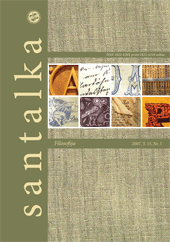The Principle of Transparency of the Sign and the Problem of Cognitive Mediation and Epistemological Immediatism
The Principle of Transparency of the Sign and the Problem of Cognitive Mediation and Epistemological Immediatism
Author(s): Józef DębowskiSubject(s): Philosophy
Published by: Vilnius Gediminas Technical University
Keywords: sign; meaning; significative intention; intentionality; the transparency of the sign; transparent mediator (medium quo); opaque mediator (medium quod); directness of cognition.
Summary/Abstract: The article consists of two parts. In the first part (I) three different formulations of the principle of the transparency of the sign are described. In the first description (E. Husserl) it is said that the sign in a proper sense (both an iconic and conventional one) is transparent for its denotations. In the second description (A. Schaff) only the transparence of its meaning is admitted. As far as the third description is concerned (L. Koj) conviction, that every sign is transparent both for a signed object and its meaning, is typical. In the second part of the article (II) we consider relationship between the principle of the transparency of the sign and traditional distinction between “transparent” and “opaque” cognitive mediator – distinction between medium quo and medium quod. The main conclusion of this article is included in a thesis that linguistic cognition and significative cognition – because it isn’t a direct cognition in the sense of primary directness (perceptive) – isn’t able to guarantee a source of access to a cognized object, so it is not a direct cognition in a proper sense. It means that the transparency of the sign, when it appears in the face of its denotations (E. Husserl’s interpretations) a sign or a system of signs are not able to function as a transparent mediator, i e medium quo. It is like that because – as E. Husserl noticed – the sign (due to its transparency) indeed shows us its denotations, but always through the mediation of its meaning and some significative intention.
Journal: Santalka: Filologija, Edukologija
- Issue Year: 15/2007
- Issue No: 1
- Page Range: 4-10
- Page Count: 7
- Language: English

